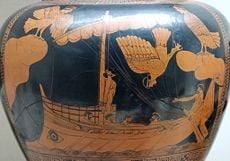Siren
- This article is about the mythological sea nymphs. For other uses of the term, see Siren (disambiguation).
In Greek mythology the Sirens or Seirenes (Greek Σειρήνες or Acheloides) were Naiads (sea nymphs) who lived on an island called Sirenum scopuli. In some different traditions they are placed on Cape Pelorum, others in the island of Anthemusa, and still others in the Sirenusian islands near Paestum, or in Capreae (Strab. i. p. 22 ; Eustath. ad Horn. p. 1709 ; Serv. I.e.}. All locations were described to be surrounded by cliffs and rocks. Approaching sailors were drawn to them by their enchanting singing, causing them to sail into the cliffs and drown. They were considered the daughters of Achelous (by Terpsichore, Melpomene or Sterope) or Phorcys (Virgil. V. 846; Ovid XIV, 88). Homer says nothing of their number, but later writers mention both their names and number ; some state that they were two, Aglaopheme and Thelxiepeia (Eustath. ad Horn. p. 1709) ; and others, that there were three, Peisinoe, Aglaope, and Thelxiepeia (Tzetz. ad LycopL7l2) or Parthenope, Ligeia, and Leucosia (Eustath. /. c.; Strab. v. pp. 246, 252 ; Serv. ad Virg. Georg. iv. 562). Their number is variously reported as between two and five, and their individual names as Thelxiepia/Thelxiope/Thelxinoe, Molpe, Aglaophonos/Aglaope, Pisinoe/Peisinoë, Parthenope, Ligeia, Leucosia, Raidne, and Teles. According to some versions, they were playmates of young Persephone and were changed into the monsters of lore by Demeter for failing to intervene when Persephone was abducted (Ovid V, 551). The term "siren song" refers to an appeal that is hard to resist but that, if heeded, will lead to a bad result.
Appearance
In early Greek art the Sirens were represented as birds with large heads and scaly feet, and sometimes manes, of lions. Later, they were represented as female figures with the legs of birds, with or without wings playing a variety of musical instruments, especially harps. The 10th century encyclopedia Suda [1] says that from their chests up Sirens had the form of sparrows, below they were women, or, alternatively, that they were little birds with women's faces. Birds were chosen because of their characteristic, beautiful voices. However, later in history Sirens were sometimes also depicted as beautiful women (whose bodies, not only their voices, are seductive), or even as mermaids (half woman, half fish). The fact that in some languages (such as Spanish, French, Italian, Polish or Portuguese) the word for mermaid is Siren, Sirène, Sirena, Syrena or Sereia adds to this confusion. In English however, "Siren" does not commonly denote "mermaid".
In his Notebooks Leonardo da Vinci wrote the following on the siren: The siren sings so sweetly that she lulls the mariners to sleep; then she climbs upon the ships and kills the sleeping mariners.
In 1917, Franz Kafka wrote in The Silence of the Sirens:
Now the Sirens have a still more fatal weapon than their song, namely their silence. And though admittedly such a thing never happened, it is still conceivable that someone might possibly have escaped from their singing; but from their silence certainly never.
Encounters with the Sirens

Odysseus was curious as to what the Sirens sounded like, so he had all his sailors plug their ears with beeswax and tie him to the mast. He ordered his men to leave him tied to the mast, no matter how much he would beg. When he heard their beautiful song, he ordered the sailors to untie him but they stuck to their orders (or they couldn't hear him). When they had passed out of earshot, Odysseus stopped thrashing about and calmed down, and was released (Odyssey XII, 39).
Jason had been warned by Chiron that Orpheus would be necessary in his journey. When Orpheus heard their voices, he drew his lyre and played his music more beautifully than they, drowning out their voices. One of the crew, however, the sharp-eared hero Butes, heard the song and leapt into the sea, but he was caught up and carried safely away by the goddess Aphrodite. It is said that after a ship successfully sailed by the Sirens, they threw themselves into the water to show protest. Varying traditions associate this event with their encounters with Jason or Odysseus, though the incident appears in neither Homer's Odyssey nor Apollonius Rhodius's Argonautica. It is also said that Hera, queen of the gods, persuaded the Sirens to enter a singing contest with the Muses. The Muses won the competition and then plucked out all of the Sirens' feathers and made crowns out of them.
In popular culture
See also
- Harpy
- Mixoparthenos
- Mermaid
- Melusine
- Pincoya
- Naiad
- Nix
- Nymph
- Lorelei, an area of the Rhine River where fishermen were drawn to their doom by enchanting songs and music.
- Water sprite
- Veela
- bird-people
- Huldra
- El Trauco
- Siren (noisemaker)
- Syrenka Coat of Arms of Warsaw
ReferencesISBN links support NWE through referral fees
Anonymous (1989) Oxford English Dictionary. Oxford University Press. Oxford.
External links
- Theoi Project, Seirenes the Sirens in classical literature and art
- A definition of Siren from the Dictionary of Greek and Roman Antiquities edited by William Smith (1870)
- The Suda (Byzantine Encyclopedia) on the Sirens
Credits
New World Encyclopedia writers and editors rewrote and completed the Wikipedia article in accordance with New World Encyclopedia standards. This article abides by terms of the Creative Commons CC-by-sa 3.0 License (CC-by-sa), which may be used and disseminated with proper attribution. Credit is due under the terms of this license that can reference both the New World Encyclopedia contributors and the selfless volunteer contributors of the Wikimedia Foundation. To cite this article click here for a list of acceptable citing formats.The history of earlier contributions by wikipedians is accessible to researchers here:
The history of this article since it was imported to New World Encyclopedia:
Note: Some restrictions may apply to use of individual images which are separately licensed.


